A CONSPECTUS OF THE LICHEN GENUS STEREOCAULON ...
A CONSPECTUS OF THE LICHEN GENUS STEREOCAULON ...
A CONSPECTUS OF THE LICHEN GENUS STEREOCAULON ...
Create successful ePaper yourself
Turn your PDF publications into a flip-book with our unique Google optimized e-Paper software.
I. MACKENZIE LAMB: A Conspectus of Stereocaulon 20 1<br />
meratum (s. Examples of this number seen in FH, LD and ups are St. evolutum GRAEWE or mixtures of<br />
St. paschale and St. evolutum). - HALE, Lich. Amer. Exs. Fasc. IV (1970) no. 98, as St. dactylophyllum<br />
(FH, LD). - HAV. Lich. EXS. Norveg. Fasc. VII (1905) no. 262 (BG); Lich. Norveg. Occid. Exs. Fasc.<br />
VII (1938) no. 153 (PR. This example has some intermixture of St. grande (MAGN.) MAGN.). - HEPP,<br />
Flechten Europas Band VZ (1857) no. 304, as St. paschale B. conglomeratum (FH, LD, PC, s.). - Krypt.<br />
Exs. Vindob. Cent. XL (1957) no. 3918 pr. p. (co~o, FH, L, LD. The examples in FH and L contain also<br />
St. alpinum LAUR. var. erectum FREY). - KUROK. Lich. Rarior. et Crit. Exs. Fasc. I11 (1971) no. 145,<br />
as St. sasakii (FH, LD). - Lich. Canad. Exs. no. 66 (1970), no. 67 (1970) (CAN). - Lichenotheca Fenn.<br />
Fasc. V (1947) no. 103, as St. squamescens, pr. p. (CAN, UPS. The example in LD is St. saxatile MAGN.);<br />
Fasc. VII (1947) no. 171 pr. p. (FH. This example is partly St. dactylophyllum FLK.); Fasc. X (1947)<br />
no. 248 (FH, HAK); Fasc. XXXI (1953) no. 760 (FH); Fasc. XXXIX (1956) no. 961 (FH); Fasc. XLIII<br />
(1957) no. 1056 (FH, with parasymbiontic Scutula); Fasc. XLIV (1958) no. 1081 (FH, with parasymbiontic<br />
Scutula); Fasc. L (1959) no. 1230, as St. subcoralloides (FH). - MAC. Canad. Lich. ser. I (1893) no.<br />
44, as St. tomentosum (WELC); ser. I1 (1909 - 12) no. 133 (FH, MSC, US. An example in WELC is St. saxatile<br />
MAGN., and one in DUKE is St. tomentosum FR.); no. 134, as St. tomentosum, pr. p. (us. The material<br />
distributed in this number was collected from four different Canadian localities. An example in<br />
DUKE is St. tomentosum FR., and one in WELC is St. saxatile MAGN.); no. 258 (us); no. 259, as St. tomentosum<br />
(us). - MAGN. Lich. Sel. Scand. Exs. Fasc. VII (1933) no. 157 (DEGEL, PR). - MALME, Lich.<br />
Suec. Exs. Fasc. XXI (1915) no. 509A, B (PR, WIS). - MERESCH. Lich. ROSS. EXS. Fasc. I1 (1913) no. 39<br />
(FH). - MIG. Cryptog. German. Austr. et Helvet. Exs. Fasc. XXV (1904) no. 123 (FH, MSC, OC, PR, u). -<br />
NORRL. et NYL. Herb. Lich. Fenn. Continuatio (1921) no. 501 ("pascale") (ups). - RABENH. Lich.<br />
Europ. Exs. Fasc. V (1856) no. 134 (PR). - RAS. Lich. Fenn. Exs. Fasc. I1 (1935) no. 57, as St. paschale<br />
var. squamescens (GB); Fasc. IV (1936) no. 197 (ups); no. 198, as St.paschale var. grandis (ups). - SAV.<br />
Lichenotheca Ross. Decas VIII (1956) no. 74, as St. alpinum (LD). - STENHAM. Lich. Suec. Exs. Fasc.<br />
I11 (1860) no. 80 (FH, LD, us); no. 81 pr. p., as St. paschale b. gracilentum (LD. In this example it occurs<br />
intermixed with St. alpinum LAUR. f. gracilentum (TH. FR.) LAMB; in that in FH it is entirely the latter). -<br />
TOBOL. Lichenotheca Polon. Fasc. VI (1955) no. 113 (FH. An example seen in LD is St. saxatile MAGN.).<br />
- TUCK. Lich. Amer. Septentr. Exs. Fasc. V (1 854) no. 112 (FH, UPS. An example seen in TENN, and one<br />
of two in FH, copiously fertile and without cephalodia, are tentatively referred to St. subintricans NYL.,<br />
a doubtful species; see p. 324). - V~ZDA, Lich. Sel. Exs. Fasc. XLIX (1974) no. 1211 (FH).<br />
Icon.: GALLBE 1972, P1. 74, figs. 566 - 572; PI. 75, figs. 573 - 578; P1. 76, figs. 579 - 583; P1. 77,<br />
figs. 584 - 587. - FREY 1932, fig. 23 ; PI. 111, figs. 1, 2. - RAs. 1951, PI. XVI, fig. 1. - YOSHIM. 1974,<br />
figs. 74a, 77d; PI. 33, fig. 331.<br />
Mat. chim.: atranorin and lobaric acid; occasionally occurring in a deficient phase with<br />
only atranorin demonstrable by present chromatographic techniques.<br />
Distrib. Sweden, Norway, Denmark, Finland, Netherlands (probably now extinct), Scotland,<br />
W. Germany, E. Germany, Poland, U. S. S. R. (including Estonia and Karelia), Mongolian People's<br />
Republic, Iceland, Greenland, Canada (N. W. Temt., Yukon Territ., British Columbia, Alberta,<br />
Saskatchewan, Manitoba, Ontario, Quebec, Labrador, Newfoundland, Nova Scotia), Miquelon<br />
Island, U. S. A. (Maine, New Hampshire, Massachusetts, where probably now extinct, Virginia, Michigan,<br />
Montana, Alaska), Manchuria, Korea, Japan (Hokkaido, Honshu), Chile (Valdivia, Magallanes),<br />
Argentina (Chubut). Unconfirmed literature records also from Belgium (DE WILDEMAN et<br />
DURAND 1898 - 1907 (1898)), N. W. France (DES ABBAYES 1934), Italy (JATTA 1900), Rumania (CRE-<br />
TZOIU 1939; MORUZI, PETRIA et MANTU 1967), Bulgaria (NIKOL<strong>OF</strong>F 1931), U. S. A., California (TUCKE-<br />
RMAN 1866), Sri Lanka (Ceylon) (BISWAS 1947, almost certainly erroneous, referring to St. austroindicum<br />
LAMB), Central Africa (LINDAU 191 I), China (MULLER ARC. 1893, erroneous, = St. myriocarpum<br />
TH. FR.), Ecuador (KREMPELHUBER 1861, erroneous, = St. myriocarpum TH. FR.).<br />
Remarks: the type species of the genus. See p. 307 for discussion of typification. The described<br />
infraspecific taxa which really belong to St. paschale (var. serpens TH. FR. and f. colligatum LAMB) are<br />
obviously environmental modifications of no taxonomic significance.

















